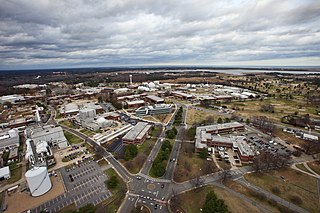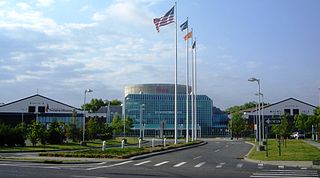
Apollo 11 was the spaceflight that first landed humans on the Moon. Commander Neil Armstrong and lunar module pilot Buzz Aldrin formed the American crew that landed the Apollo Lunar Module Eagle on July 20, 1969, at 20:17 UTC. Armstrong became the first person to step onto the lunar surface six hours and 39 minutes later on July 21 at 02:56 UTC; Aldrin joined him 19 minutes later. They spent about two and a quarter hours together outside the spacecraft, and collected 47.5 pounds (21.5 kg) of lunar material to bring back to Earth. Command module pilot Michael Collins flew the Command Module Columbia alone in lunar orbit while they were on the Moon's surface. Armstrong and Aldrin spent 21 hours, 36 minutes on the lunar surface, at a site they had named Tranquility Base upon landing, before lifting off to rejoin Columbia in lunar orbit.

The Lunar Roving Vehicle (LRV) is a battery-powered four-wheeled rover used on the Moon in the last three missions of the American Apollo program during 1971 and 1972. It is popularly called the Moon buggy, a play on the term dune buggy.

The Langley Research Center, located in Hampton, Virginia, United States, is the oldest of NASA's field centers. It directly borders Langley Air Force Base and the Back River on the Chesapeake Bay. LaRC has focused primarily on aeronautical research, but has also tested space hardware at the facility, such as the Apollo Lunar Module. In addition, a number of the earliest high-profile space missions were planned and designed on-site, and Langley was considered a potential site for NASA's Manned Space Center prior to the eventual selection of Houston, Texas.

Robert Rowe Gilruth was an American aerospace engineer and an aviation/space pioneer who was the first director of NASA's Manned Spacecraft Center, later renamed the Lyndon B. Johnson Space Center.

Cosmosphere is a space museum and STEM education center in Hutchinson, Kansas, United States. It was previously known as the Kansas Cosmosphere. The museum houses over 13,000 spaceflight artifacts—the largest combined collection of US and Russian spaceflight artifacts in the world—and is home to internationally acclaimed educational programs.

The Apollo command and service module (CSM) was one of two principal components of the United States Apollo spacecraft, used for the Apollo program, which landed astronauts on the Moon between 1969 and 1972. The CSM functioned as a mother ship, which carried a crew of three astronauts and the second Apollo spacecraft, the Apollo Lunar Module, to lunar orbit, and brought the astronauts back to Earth. It consisted of two parts: the conical command module, a cabin that housed the crew and carried equipment needed for atmospheric reentry and splashdown; and the cylindrical service module which provided propulsion, electrical power and storage for various consumables required during a mission. An umbilical connection transferred power and consumables between the two modules. Just before reentry of the command module on the return home, the umbilical connection was severed and the service module was cast off and allowed to burn up in the atmosphere.

The Bell Aerosystems Lunar Landing Research Vehicle was a Project Apollo era program to build a simulator for the Moon landings. The LLRVs were used by the FRC, now known as the NASA Armstrong Flight Research Center, at Edwards Air Force Base, California, to study and analyze piloting techniques needed to fly and land the Apollo Lunar Module in the Moon's low gravity environment.

The U.S. Space & Rocket Center in Huntsville, Alabama is a museum operated by the government of Alabama, showcasing rockets, achievements, and artifacts of the U.S. space program. Sometimes billed as "Earth's largest space museum", astronaut Owen Garriott described the place as, "a great way to learn about space in a town that has embraced the space program from the very beginning."

The Wright Flyer was the first successful heavier-than-air powered aircraft. Designed and built by the Wright brothers, they flew it four times on December 17, 1903, near Kill Devil Hills, about 6 kilometers south of Kitty Hawk, North Carolina. Today, the airplane is exhibited in the National Air and Space Museum in Washington D.C. The U.S. Smithsonian Institution describes the aircraft as "the first powered, heavier-than-air machine to achieve controlled, sustained flight with a pilot aboard." The flight of the Wright Flyer marks the beginning of the "pioneer era" of aviation.

The California Science Center is a state agency and museum located in Exposition Park, Los Angeles, next to the Natural History Museum of Los Angeles County and the University of Southern California. Billed as the West Coast's largest hands-on science center, the California Science Center is a public-private partnership between the State of California and the California Science Center Foundation. The California Natural Resources Agency oversees the California Science Center and the California African American Museum. Founded in 1951 as the "California Museum of Science and Industry", the Museum was remodeled and renamed in 1998 as the "California Science Center". The California Science Center hosts the California State Science Fair annually.

The Kennedy Space Center Visitor Complex is the visitor center at NASA's Kennedy Space Center on Merritt Island, Florida. It features exhibits and displays, historic spacecraft and memorabilia, shows, two IMAX theaters, and a range of bus tours of the spaceport. The "Space Shuttle Atlantis" exhibit contains the Atlantis orbiter and the Shuttle Launch Experience, a simulated ride into space. The center also provides astronaut training experiences, including a multi-axial chair and Mars Base simulator. The visitor complex also has daily presentations from a veteran NASA astronaut. A bus tour, included with admission, encompasses the separate Apollo/Saturn V Center. There were 1.7 million visitors to the visitor complex in 2016.

The Cradle of Aviation Museum is an aerospace museum located in Garden City, New York on Long Island to commemorate Long Island's part in the history of aviation. It is located on land once part of Mitchel Air Force Base which, together with nearby Roosevelt Field and other airfields on the Hempstead Plains, was the site of many historic flights. So many seminal flights had occurred in the area that, by the mid-1920s, the cluster of airfields was already dubbed the "Cradle of Aviation", the origin of the museum's name.

Space Center Houston is a science museum which serves as the official visitor center of NASA Johnson Space Center in Houston. It earned a place as a Smithsonian Affiliate museum in 2014. The organization is owned by NASA and operated under a contract by the nonprofit Manned Spaceflight Education Foundation, a 501(c)(3) organization. The Johnson Space Center is the home of Mission Control and astronaut training.

The Lunar Landing Research Facility was an area at NASA's Langley Research Center in Hampton, Virginia that was used to simulate Apollo Moon landings with a mock Lunar Module powered by a small rocket motor suspended from a crane over a simulated lunar landscape.

The Rendezvous Docking Simulator, also known as the Real-Time Dynamic Simulator, is a simulator at the Langley Research Center. It was constructed for the Gemini program in Building 1244 and it became operational in June 1963 at a cost of $320,000 and later reconfigured for the Apollo program. The simulator consists of a gantry frame, with an overhead carriage from which test craft were suspended by cables. A gimbal was powered hydraulically and was capable of changing pitch and yaw at a rate of 1 radian per second or roll at 2 radians per second. The gantry also moved like an overhead crane using electric motors and was capable of travelling 210 feet (64 m) longitudinally at up to 20 feet per second (6.1 m/s), 16 feet (4.9 m) laterally at up to 4 feet per second (1.2 m/s) and vertically 45 feet (14 m) at up to 10 feet per second (3.0 m/s).

The Stafford Air & Space Museum is located in Weatherford, Oklahoma, United States. The museum, named for NASA astronaut and Weatherford native Thomas P. Stafford, became a Smithsonian Affiliate in June 2010. The museum features exhibits about aviation, space exploration, and rocketry, and a collection of over 20 historic aircraft. Displays include artifacts from the Space Shuttle program, Hubble Space Telescope, and the Mir Space Station, a Moon rock, Stafford's Apollo 10 spacesuit, the Gemini 6A spacecraft, a Titan II missile, and a Mark 6 re-entry vehicle.
As the coalition of Bay Areas counties predicted when it lobbied for the creation of Moffett Federal Airfield in the late 1920s, the base's research program and facilities catalyzed the development of numerous private technology and aerospace corporations, among them Lockheed Martin and the Hiller Aircraft Corporation.
Norman L. Crabill is a retired NASA engineer. An employee of NASA since its creation in 1958, Crabill was originally employed by its predecessor National Advisory Committee for Aeronautics, or NACA. Over the course of his nearly 40-year career, he was recognized for numerous achievements. Crabill has written 43 publications. He was inducted into the Virginia Aviation Hall of Fame in 2003.

Apollo 11 was the first human spaceflight to land on the Moon. In the decades after its 1969 mission took place, widespread celebrations have been held to celebrate its anniversaries.






















